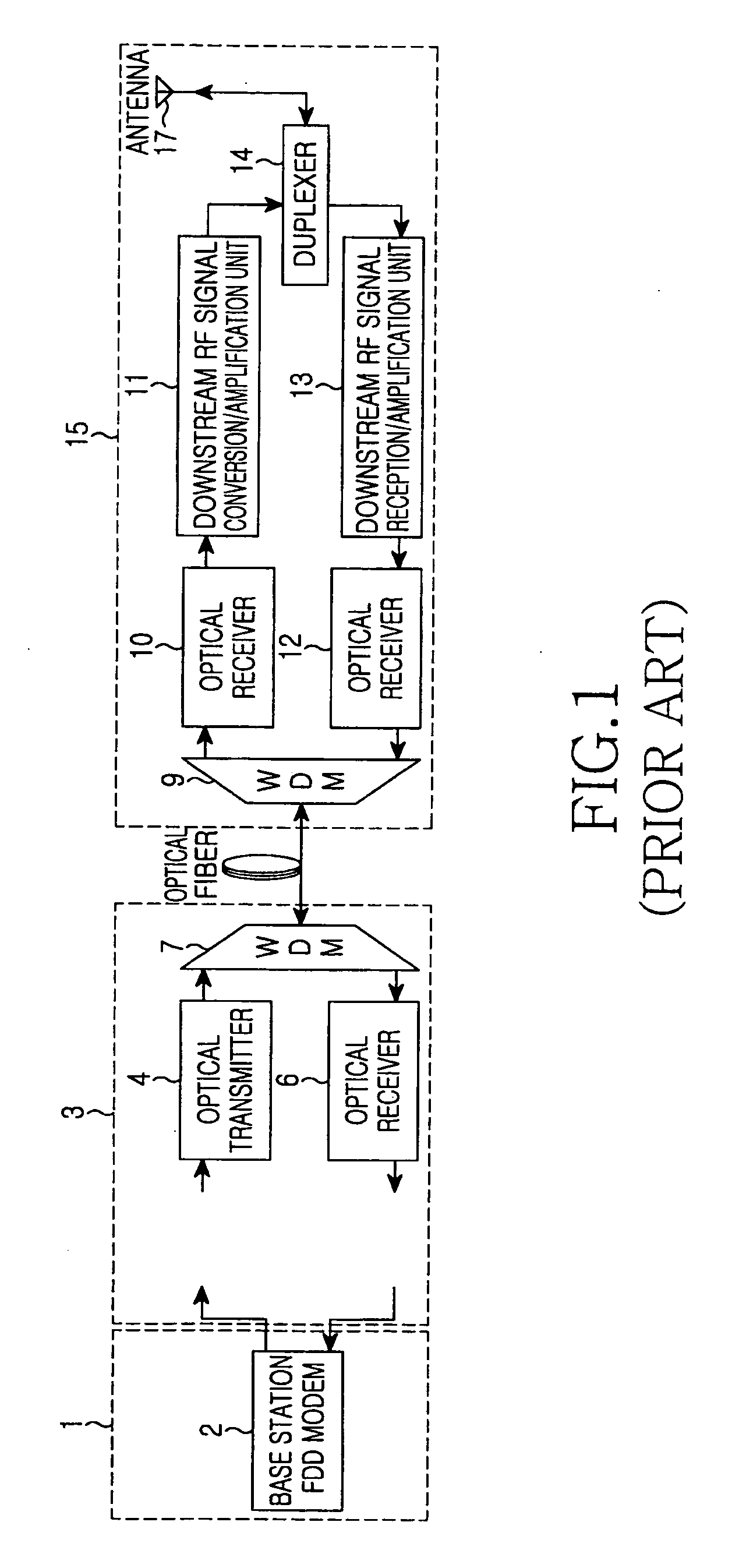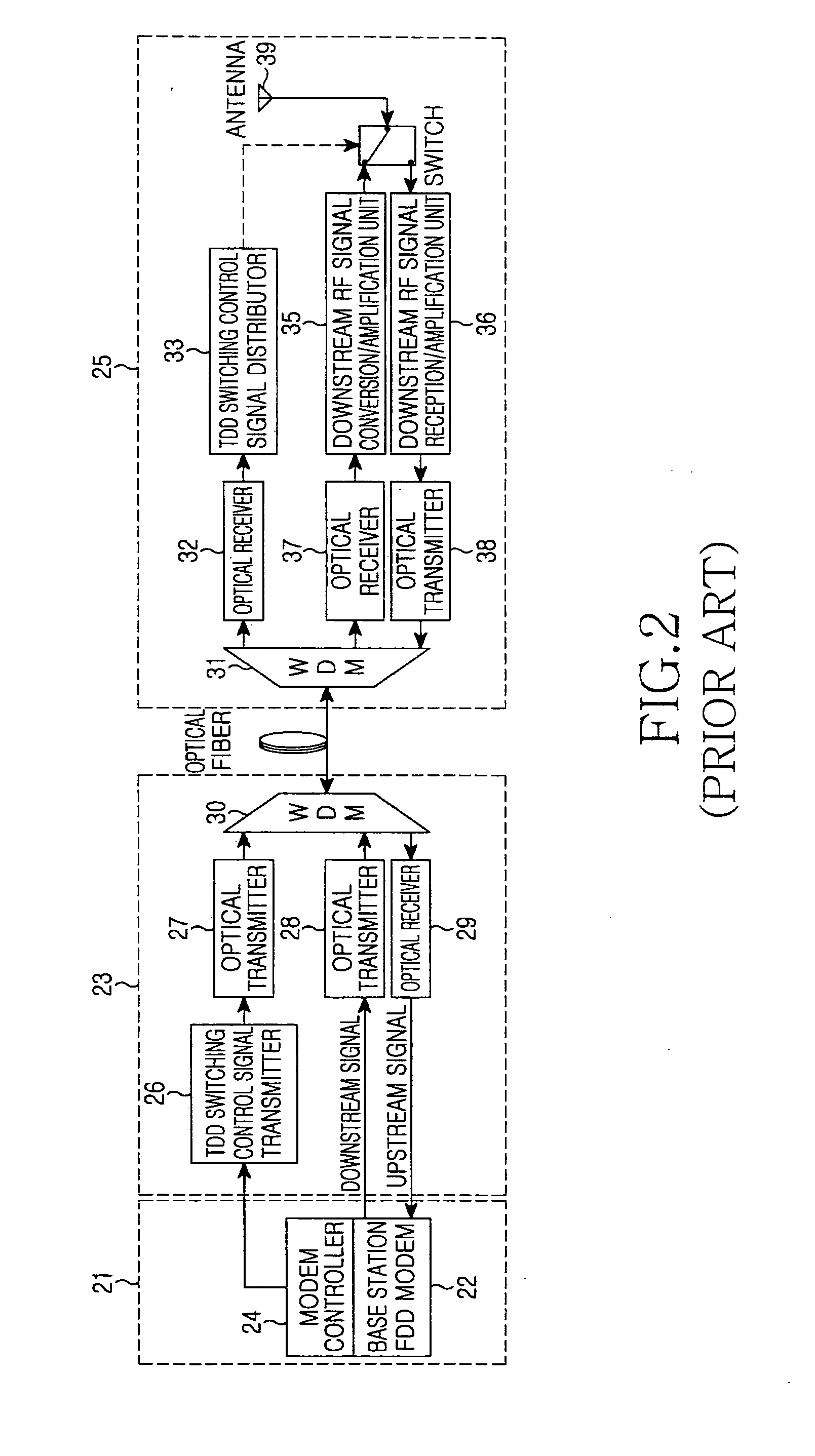RoF system providing HD wireless communication service and signal control method for the same
a wireless communication and wireless communication technology, applied in the field of wireless communication systems, can solve the problems of reducing transmission efficiency, limited fdd scheme in providing variable asymmetric services, and increasing guard time between transmission and reception
- Summary
- Abstract
- Description
- Claims
- Application Information
AI Technical Summary
Benefits of technology
Problems solved by technology
Method used
Image
Examples
first embodiment
[0037]In line with this, FIG. 3 is an exemplary view of a radio-over-fiber (RoF) system to which a hybrid duplexing (HD) scheme is applied, according to the present invention. As shown in FIG. 3, a base station (BS) logically has two cell radiuses 350 and 360, and a service mobile terminal 104 located relatively nearer to the base station antenna has a good wireless channel state and thus has a high probability to receive a broadband data service. Therefore, the service mobile terminal 104 can receive a service by resource assignment of a TDD link advantageous for such a service. However, in a case of a mobile terminal 310 located within a cell 360 relatively far from the base station antenna, it is advantageous to receive a service through FDD links because the round-trip time delay problem occurs much less. That is, it can be said that a broadband TDD mode is relatively advantageous to the mobile terminal 104 relatively nearer to the base station antenna, whereas a narrowband FDD ...
second embodiment
[0048]FIG. 7 is a block diagram illustrating a construction of a wireless communication system operating in a TDD mode, according to the present invention. Referring to FIG. 7, in a case where upstream signals received from wireless terminals through an antenna 721 of the RS 745 are TDD mode upstream signals, when the TDD upstream signals are input to a switching unit 722 through an RF duplexer #1720 after the direction-adjustment of the circulator 719, the switching unit 722 is connected to a corresponding path of the TDD upstream signals according to the control of the TDD switching control signal unit 729. Then, the resultant signals are input to an LNA #1723, so that weak signals are low noise-amplified. In this case, the switching of the FDD upstream signal path is grounded by an RF terminator.
[0049]Moreover, the low noise-amplified TDD upstream signals are input to the base station donor 740 via a duplexer #2724 and an upstream optical transmitter 725. The TDD upstream signals...
third embodiment
[0052]FIG. 8 is a block diagram illustrating a construction of a wireless communication system operating in an FDD mode, according to the present invention. Referring to FIG. 8, when upstream signals received from wireless terminals through an antenna 821 of the RS 845 are FDD mode upstream signals, the FDD upstream signals are low-noise amplified by an LNA #2826 through an RF duplexer #1820, and the resultant signals are connected to the second duplexer 824 according to the control of the TDD / FDD mode control signal unit 828. In this case, a first RF switch 822 of a TDD upstream signal path is grounded by an RF terminator under the control of the TDD switching control signal unit 829.
[0053]Then, the FDD upstream signals are delivered to the base station donor 840 via an RF duplexer #2824 and an upstream optical transmitter 825. The FDD upstream signals received from the RS 845 through an upstream optical link are input to an upstream optical receiver 814, and are divided according ...
PUM
 Login to View More
Login to View More Abstract
Description
Claims
Application Information
 Login to View More
Login to View More - R&D
- Intellectual Property
- Life Sciences
- Materials
- Tech Scout
- Unparalleled Data Quality
- Higher Quality Content
- 60% Fewer Hallucinations
Browse by: Latest US Patents, China's latest patents, Technical Efficacy Thesaurus, Application Domain, Technology Topic, Popular Technical Reports.
© 2025 PatSnap. All rights reserved.Legal|Privacy policy|Modern Slavery Act Transparency Statement|Sitemap|About US| Contact US: help@patsnap.com



